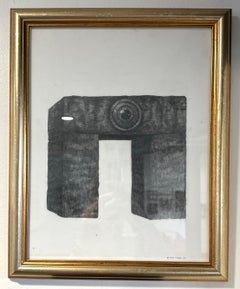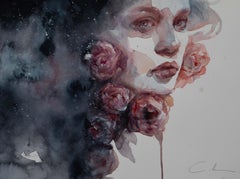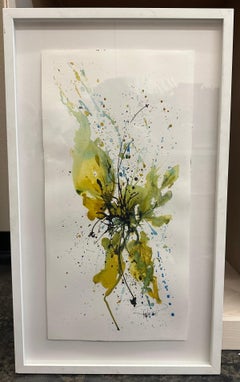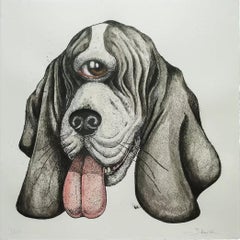Want more images or videos?
Request additional images or videos from the seller
1 of 7
Vera NeumannVera Paints Unique Nauticals1965
1965
$3,000List Price
About the Item
- Creator:Vera Neumann (1909 - 1993, American)
- Creation Year:1965
- Dimensions:Height: 22.5 in (57.15 cm)Width: 15.5 in (39.37 cm)
- Medium:
- Movement & Style:
- Period:
- Condition:
- Gallery Location:Dallas, TX
- Reference Number:1stDibs: LU1472216087182
About the Seller
5.0
Vetted Professional Seller
Every seller passes strict standards for authenticity and reliability
Established in 2020
1stDibs seller since 2020
96 sales on 1stDibs
Authenticity Guarantee
In the unlikely event there’s an issue with an item’s authenticity, contact us within 1 year for a full refund. DetailsMoney-Back Guarantee
If your item is not as described, is damaged in transit, or does not arrive, contact us within 7 days for a full refund. Details24-Hour Cancellation
You have a 24-hour grace period in which to reconsider your purchase, with no questions asked.Vetted Professional Sellers
Our world-class sellers must adhere to strict standards for service and quality, maintaining the integrity of our listings.Price-Match Guarantee
If you find that a seller listed the same item for a lower price elsewhere, we’ll match it.Trusted Global Delivery
Our best-in-class carrier network provides specialized shipping options worldwide, including custom delivery.You May Also Like
The Sketch Class, Figurative Study Line Drawing
By David Rosen (b.1912)
Located in Soquel, CA
Expressive line drawing figure study featuring a group of figures in a classroom by David Rosen (Canadian, 1912-2004). Unsigned, but was acquire...
Category
Late 20th Century American Modern Figurative Drawings and Watercolors
Materials
Paper, Pen, Watercolor
$680 Sale Price
20% Off
H 12 in W 8 in D 0.25 in
Two Nude Figures - Modernist Abstract Figure Study in Red & Blue
By David Hill
Located in Soquel, CA
Gorgeous and compelling modern figural study with two figures by David Hill (American, 20th century). The figures, which are rendered in red and blue, are posed in a dynamic conversa...
Category
Early 2000s Modern Figurative Drawings and Watercolors
Materials
Paper, Watercolor
$556 Sale Price
20% Off
H 22 in W 18 in D 2 in
Untitled Abstraction with Gold by Annemarie Graupner
Located in Hudson, NY
Minimalist work by Annemarie Graupner, in a charming hand-carved wood frame. Perfect for an intimate nook.
About this artist: Swiss artist Annemarie Graupner, granddaughter of the S...
Category
20th Century Modern Abstract Drawings and Watercolors
Materials
Gold Leaf
$1,600
H 5.5 in W 3.75 in
Sergey CHEKHONIN (1878 – 1936), theater poster project
Located in Paris, FR
Serge Tchekhonine was a Russian artist who studied applied drawing, ceramics, and pottery in St. Petersburg. He settled in France in 1928, gaining attention for his finely crafted ce...
Category
1930s Modern Abstract Drawings and Watercolors
Materials
Paper, Ink, Watercolor, Gouache
$30,083
H 15.16 in W 10.63 in
Italy Goes to War
By Arthur Dove
Located in Bryn Mawr, PA
Provenance
An American Place, New York;
World House Galleries, New York, 1953;
Private collection, New York;
Betty Krulik Fine Art, 2007;
Avery Galleries until present
Exhibitions
An American Place, New York, Exhibition of New Arthur G. Dove Paintings...
Category
1940s American Modern Abstract Drawings and Watercolors
Materials
Paper, Watercolor
"NY Street Signs" Mid-20th Century WPA 1938 Modernist Abstract Realism Pop Art
By Stuart Davis
Located in New York, NY
"NY Street Signs" Mid-20th Century WPA 1938 Modernist Abstract Realism Pop Art
Stuart Davis (American, 1892-1964) "Street Signs" Modernist gouache and traces of pencil on paper in the proto-pop art style Davis is celebrated for, 1938, signed to lower right, framed. Image: 11 1/4 x 15 1/4 inches. Frame by Bark: 18 1/2 x 22 inches.
LITERATURE: A, Boyajian, M. Rutkowski, Stuart Davis, A Catalogue Raisonne, Vol. 2, New Haven, Connecticut, 2007, vol. II, p. 632, no. 1232, illustrated.
EXHIBITIONS: ACA Galleries, New York American Artists' Congress: Group Exhibition of Paintings and Sculpture, Dec. 3-16, 1939 (SDAB I, 12/3/39, p. 129). Outlines Gallery, Pittsburgh, Stuart Davis, Mar. 3-16, 1946. Coleman Art Gallery, Philadelphia, 5 Prodigal Sons: Former Philadelphia Artists: Ralston Crawford, Stuart Davis, Charles Demuth, Julian Levi, Charles Sheeler, Oct 4 - 30, 1947 (pamphlet), no. 12.
PROVENANCE: The artist; Mr. and Mrs. Frank Bowles, New York, Apr. 3, 1956; thence by descent, Private Collection, New York.
NOTES: According to the Catalogue Raissonne, "the title 'Street Signs' is recorded in the artist's account books...
Category
1930s American Modern Abstract Drawings and Watercolors
Materials
Paper, Gouache, Pencil
$125,000
H 18.5 in W 22 in D 1 in
"Barns" Watercolor Mid-20th Century Modern Abstract Realism Excellent Provenance
By Arthur Dove
Located in New York, NY
"Barns" Watercolor Mid-20th Century Modern Abstract Realism Excellent Provenance
Arthur Dove (1880-1946)
"Barns"
5 x 7 inches
Watercolor on paper, 19...
Category
1940s American Modern Abstract Drawings and Watercolors
Materials
Paper, Watercolor
MODERNIST DRAWING New Hope Mid-Century WPA Abstract Non-Objective Jazz Modern
By Ramstonev (Ramsey/Stone/Evans co-operative)
Located in New York, NY
MODERNIST DRAWING New Hope Mid-Century WPA Abstract Non-Objective Jazz Modern. Signed with a "Ramstonev" stamp lower right.
RAMSTONEV Cooperative Art Project (1937-1939). In the late 1930s, Charles Ramsey became close friends with Charles Evans and Louis Stone. He persuaded them to join him teaching his New Hope summer classes in non-objective painting. Soon, a history-making collaboration began. In 1937, meeting in Evans' studio at the rear of Cryer's Hardware store on Main Street in New Hope, a decision was made to establish the Co-Operative Painting Project. They were intrigued by the cooperative ad-lib process by which jazz musicians created their music. Believing this to be the quintessential American contribution to music, they theorized that a similar result might be obtainable with art, a "visual jam session." This particlarly fascinated Ramsey, who was a jazz buff and had a large collection of jazz records.
The objective was to jointly collaborate in the creation of a painting as well as applying collective criticism during its creation. By creating forward movement by general consent, they believed they could produce a higher level of beauty. By consensus it was decided that subject matter would be non-objective. Up to eight people would participate and stop when the painting "felt" finished by common agreement.
These co-operative works were done in several different mediums- the majority in pastel, but some in watercolor, gouache, graphite or cut paper collage. On occasion, the group would create a series, as opposed to a single work, created in steps by three or four artists. One of the occasional participants was famed New Hope poet, Stanley Kunitz. These series could range in number from four to sixteen paintings in each. The first of a series would be very basic and the last a fully finished work.
In the scope of importance among the New Hope Modernist...
Category
1930s American Modern Abstract Drawings and Watercolors
Materials
Paper, Watercolor, Gouache
Abstract Work on Paper Mid-Century Modernism Greek American Gouache Drawing
By Jean Xceron
Located in New York, NY
Abstract Work on Paper Mid-Century Modernism Greek American Gouache Drawing.
A modernist artist who emigrated to America from Greece in 1904, when he was fourteen years old, Jean Xceron is described as having a reputation as an artist that has mysteriously fallen into obscurity---especially since he was reportedly quite prominent during his lifetime. However, a partial explanation of that omission is the fact that many of his papers and early records have been lost. He was a painter of biomorphic abstractions and did collages, which were influenced by Dadaism.
Xceron was active in New York City when modernism was gaining influence. Of him during this period, it was written that his artistic role was "a vital link between what is commonly termed as the first-generation (the Stieglitz group, the Synchromists, etc.) and second-generation, the American Abstract Artists, the Transcendental Painting...
Category
1940s American Modern Abstract Drawings and Watercolors
Materials
Paper, Gouache
$6,000
H 24 in W 20 in D 2 in
“Floating Forms”
By Rolph Scarlett
Located in Southampton, NY
Mid century modern gouache on paper by the well known Canadian/American artist, Rolph Scarlett. Signed and dated in blue pen lower left, 1947. Condition: Good. Framed in thin black matte painted frame with acid free white mat. Not examined out of frame. Overall framed 14.25 by 17 inches.
ROLPH SCARLETT (1889-1984)
Rolph Scarlett was born 1889 in Guelph, Ontario. His long life as an artist began in his teens as a jewelry designer and fabricator. At the age of fourteen he began to design jewelry professionally, a craft which he continued off and on for the rest of his life.
His desire to learn more about art took him to New York in 1908, when American artists were just beginning to experience strong influences from major modern European artists of the day such as Cezanne and Picasso.
Throughout his long career he produced, oil paintings, many works on paper, unique sculptured jewelry, modernist style industrial and furniture designs. Currently there are over 800 of his designs at the Montreal Museum of Fine Arts Design Collection.
In 1928 he moved to Hollywood, California where he became a very successful stage and set designer. In the mid-1930s he met the director of the Museum of Non-objective Art in New York ( Hilla Rebay). He became her close associate and advisor in organizing and running the museum. He was Chief lecturer at the museum (1939 -1946) teaching the new modernism and abstraction to the new generation of artists in the New York art community. Hilla Rebay would introduce him as “Rolph Scarlett, my great find”. So considerable was her enthusiasm for Scarlett, that she and Solomon Guggenheim bought over sixty of his paintings and monotypes for the museum. After Kandinsky and Bauer, there was more of Scarlett’s work in the collection than any other artists.
He participated in many of the museum exhibitions and galleries and was regularly exhibiting his work in Los Angeles, the San Francisco Art Museum, the Art Institute in Chicago, the Modern Age Gallery in N.Y., the Metropolitan Museum, the Whitney Museum and the Museum of Modern Art. He studied for a time at the Art Student League with William Merrit...
Category
1940s Modern Abstract Drawings and Watercolors
Materials
Paper, Gouache
More From This Seller
View AllUntitled
Located in Dallas, TX
Pencil drawing of a furry structure with an eye. Surrealist artwork.420
Category
21st Century and Contemporary Surrealist Abstract Drawings and Watercolors
Materials
Pencil
$336 Sale Price
20% Off
Space Peonies
Located in Dallas, TX
Water color abstract cloud of flowers with face appearing from it
Category
21st Century and Contemporary Portrait Drawings and Watercolors
Materials
Watercolor
$1,920 Sale Price
64% Off
Curves of Spring
Located in Dallas, TX
Watercolor work on paper. Abstract expressionist interpretation of spring.
Category
21st Century and Contemporary Abstract Expressionist Abstract Paintings
Materials
Watercolor
$800 Sale Price
20% Off
Your Son Just Bit My Dog (Black & White Varied Ed. /9)
Located in Dallas, TX
'Your Son Just Bit My Dog' is by Jacob Taylor, a young Welsh artist currently working in a care home to subsidize his early career. His first exhibition in July 2022 at Laz Emporium ...
Category
21st Century and Contemporary Contemporary Animal Prints
Materials
Watercolor, Screen
The First Lady (Grey & Gold Ed. /15)
By Penny
Located in Dallas, TX
"The First Lady"
22 layer hand cut stencil
Spray paint on $1 bill
15.6 x 6.6cm
Signed HPM of 15
2013
British stencil artist Jim Penfold aka Penny (aka Onepennypiece) is known for ...
Category
21st Century and Contemporary Street Art Figurative Paintings
Materials
Paper, Spray Paint, Stencil
$1,280 Sale Price
20% Off
Let Them Eat - Cake
By Penny
Located in Dallas, TX
16 layer hand cut stencil, spray paint on genuine 10 Pound banknote, C-Type semi gloss printed detail, signed and dated edition of 10
2 7/8 x 5 3/4 in
7.2 x 14.5 cm
Edition of 10 plu...
Category
21st Century and Contemporary Street Art Figurative Paintings
Materials
Spray Paint, Tissue Paper, Stencil
$720 Sale Price
65% Off



